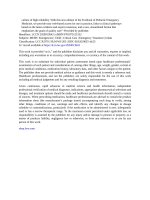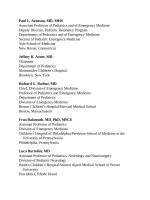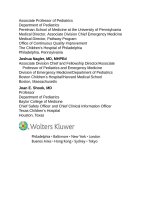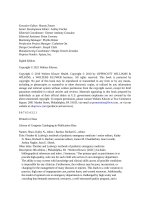Pediatric emergency medicine trisk 2721 2721
Bạn đang xem bản rút gọn của tài liệu. Xem và tải ngay bản đầy đủ của tài liệu tại đây (108.94 KB, 1 trang )
syncytial virus (RSV) prophylaxis with RSV immunoglobulin (palivizumab) may be
used in children younger than 1 year on highly immunosuppressive regimens.
Approach to the Febrile Oncology Patient
Definition of fever: Temperature >38 on two occasions
separated by 1-2 hours or temperature re >38.5 one time
Check CBC with differential:
Does the patient have ANC < 500?
Yes
No
t
t
Does the patient have a
central line (CVL) ?
Immediate blood culture and
administration of broad-spectrum
antibiotics*
No
Yes
Y
Obtain blood culture and
consider administration of
IV antibiotics **
^'
Pursue evaluation and management as
dictated by signs and symptoms from history
and physical examination
'Antibiotics used in Empiric Therapy of Febrile Neutropenia
(Initial ED dosing )
• Standard Regimens
• Cefepime 50 mg/kg IV (maximum dose 2,000 mg)
• Ceftazidime 50 mg/kg IV (maximum dose 2,000 mg)
• A semisynthetic penicillin with an aminoglycoside
• Example: Piperacillin/tazobactam 75 mg/kg IV
(maximum dose 4,500 mg) and Gentamicin 2.5 mg/kg IV
• Cephalosporin and/or anaphylactic penicillin allergy
• Clindamycin 13 mg/kg IV ( maximum dose 900 mg) and
aztreonam 30 mg/kg IV (maximum dose 2,000 mg)
"Options for management of Fever and non-Neutropenia in Patients with a CVL
• Ceftriaxone 50 mg/kg IV ( maximum dose 2,000 mg)
• Other institutional guidelines which may include no antibiotic therapy
See text for considerations for additional coverage
FIGURE 98.4 Management guidelines for the febrile oncology patient. Risk assessment and
management hinges substantially on whether the absolute neutrophil count (ANC) is below 500,
whether the patient has localizing signs or symptoms, and whether an indwelling catheter is
present.
Pediatric oncology patients are also at risk for common viral infections such as
RSV, CMV, EBV, influenza, and adenovirus. In general, the presentation of these
infections is the same as in immunocompetent hosts. Of note, primary varicella









